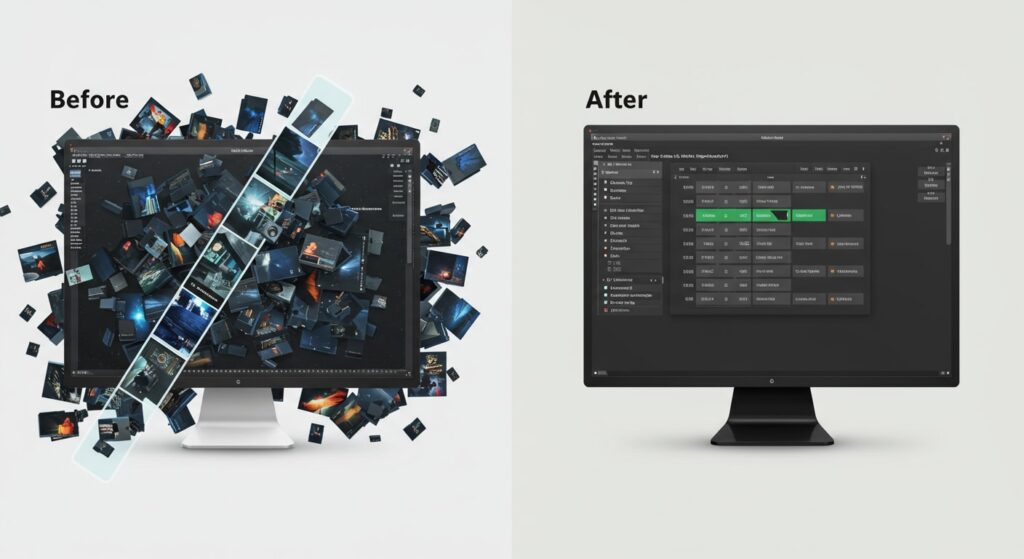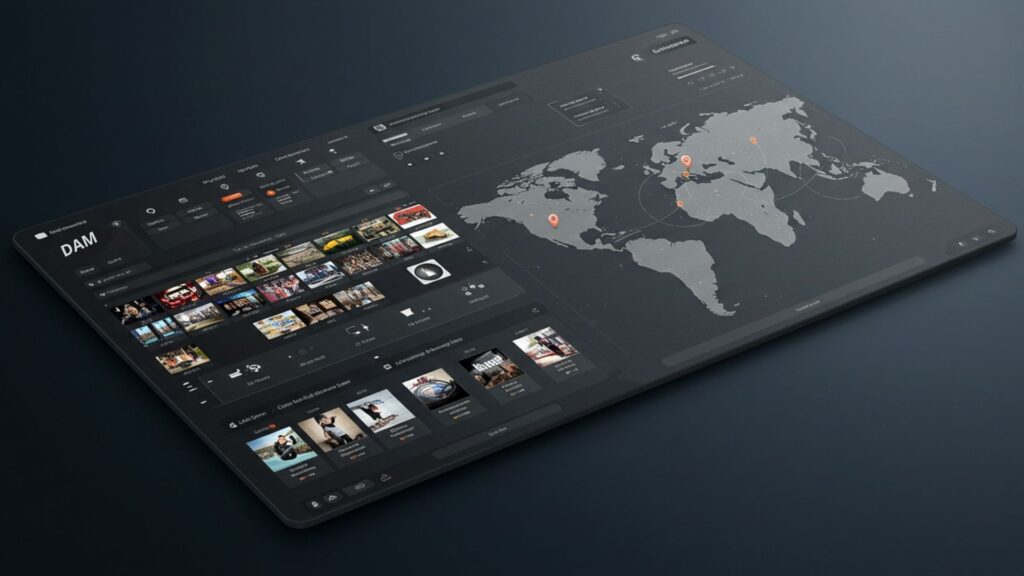Content demands are skyrocketing. Marketing teams are producing more digital content than ever before, including videos, product imagery, and campaign collateral. All these digital assets need to be securely stored, efficiently accessed, and distributed across multiple channels.
Yet as content ecosystems scale, so do the complexities in managing them. According to the Content Marketing Institute, 61% of enterprise marketers cite communicating across organizational silos as their biggest non-creation challenge, highlighting the urgent need for more connected, transparent content operations.
Enterprise DAM solutions that are purpose-built for the complexity of large-scale teams meet this challenge head-on. Far beyond basic file storage, these systems serve as centralized hubs for managing digital assets, enabling secure access, version control, advanced search capabilities, and brand governance. They ensure that creative and marketing teams can find, use, and repurpose the right assets at the right time, reducing redundancy, increasing productivity, and preserving brand integrity across every market.
For enterprise organizations looking to maximize asset value and maintain operational efficiency, a modern DAM system is a necessity.
Enterprise DAM Solutions Built for the Scale and Complexity of Global Teams
Modern enterprises operate in a fast-paced, decentralized environment where marketing campaigns span global regions, involve cross-functional teams, and require consistent brand messaging across dozens (if not hundreds) of channels.
In this context, enterprise DAM solutions function as mission-critical infrastructure that powers scalable content operations. These systems are specifically engineered to meet the volume, velocity, and variability of enterprise content needs, enabling organizations to streamline processes, support distributed teams, and align creative and marketing functions under one unified strategy.
Unlike basic digital asset management (DAM) software that may suffice for smaller teams, enterprise-grade DAM systems support complex workflows and granular access control. They integrate with existing tools such as Adobe Creative Cloud, customer relationship management (CRM) platforms, and content management systems. From promotional videos and campaign graphics to product imagery and brand guidelines, your digital assets are centralized within a secure, searchable, and scalable environment. This eliminates silos, enhances collaboration tools, and ensures that only authorized users have access to approved assets, reducing brand risk while increasing content velocity.
For large organizations, the right enterprise DAM software is the backbone of efficient and effective content operations.
From Chaos to Clarity: Organizing Your Digital Assets with Precision
When digital assets are scattered across personal drives, outdated portals, or disconnected cloud tools, even the most talented teams can get bogged down. Searching for the latest campaign image, verifying if an asset has usage rights, or ensuring a file aligns with updated brand guidelines shouldn’t derail a creative workflow.
Successful enterprise organizations rely on structured, scalable systems to bring order to content chaos. A modern digital asset management system actively organizes, labels, and surfaces the right assets when they’re needed most.
By turning fragmented content libraries into a single source of truth, enterprise DAM solutions dramatically improve asset findability, reduce time wasted on manual searches, and support faster decision-making across departments.

Centralized Asset Library for Unified Access
An intelligent asset library gives teams easy access to up-to-date files without the need to dig through folders or Slack threads. Whether you’re a brand manager in London or a product marketer in Singapore, a centralized DAM system ensures you’re always working from the same set of approved assets. With advanced search capabilities powered by metadata, tagging, and AI-driven recognition, users can locate assets based on usage rights, campaign, product line, or visual characteristics.
For example, a global retailer launching seasonal campaigns across five continents can empower local teams to self-serve content while ensuring everything aligns with the master brand. This keeps asset utilization high and asset retrieval friction low—key drivers of marketing efficiency at scale.
Real-Time Collaboration Across Departments and Geographies
Smooth collaboration shouldn’t stop at the creative team. Enterprise DAM systems support real-time teamwork between creative, legal, compliance, and product departments by embedding customizable workflows into the content lifecycle. These workflows define who reviews, approves, or updates content, ensuring that nothing moves forward without the right eyes on it.
Rather than relying on email chains or shared drives, users can collaborate directly within the DAM platform, using annotations, version histories, and feedback threads. For example, when launching a new product, a creative team can upload draft visuals, legal can review disclaimers, and brand leads can validate brand consistency in one secure platform. When teams are aligned, you can prevent costly delays while ensuring marketing materials are both compliant and on-brand from day one.
The Power of an Intelligent DAM System
A modern digital asset management system intelligently adapts to how enterprise teams work. As digital ecosystems expand, organizations need tools that keep pace, anticipate needs, automate repetitive tasks, and enforce policy without slowing down productivity. An intelligent DAM system integrates into the heart of your content operations, ensuring seamless collaboration, operational agility, and robust security measures across global teams.
By embedding smart workflows, automation, and flexible governance into the DAM foundation, enterprise companies gain strategic control over how digital assets move from creation to activation.
Automation that Adapts to Complex Enterprise Workflows
Managing thousands of assets manually is unsustainable at scale. With workflow automation built into your enterprise DAM, repetitive processes like tagging, file conversions, and asset expirations become streamlined. Sophisticated systems support customizable workflows for creative reviews, legal approvals, and regional adaptations. Your organization can keep content moving efficiently without relying on email reminders or one-off check-ins.
For instance, a healthcare company preparing product collateral for multiple markets can use automated workflows to manage translations, legal reviews, and compliance validations while tracking asset status in real time. By syncing with existing workflows across tools like project management systems, marketing calendars, and creative software, teams stay aligned and agile, regardless of scale.
Access Controls that Balance Agility and Governance
One of the most critical functions of an enterprise-grade DAM solution is its ability to offer flexible, layered access controls. Only authorized users can view, edit, or distribute specific content, protecting sensitive campaigns, regional assets, and embargoed releases from accidental exposure. With role-based permissions and audit trails, enterprises can maintain transparency and accountability while enabling speed.
Think of a global financial services firm that needs to distribute updated pitch decks and brand assets across multiple regions. With the right digital asset management solution, the global team can retain administrative control while giving local markets secure access to tailor content without compromising brand integrity or regulatory compliance. A solid governance framework is essential for productivity, risk mitigation, and legal oversight.
Choosing the Right DAM Platform for Strategic Growth
Enterprise organizations need a DAM solution that grows with them. Whether expanding into new markets, launching new products, or evolving brand positioning, a flexible DAM platform becomes a foundation for long-term content success. The right system should adapt to new distribution channels, support global operations, and empower creative and marketing teams with the agility to meet changing demands.
Choosing a scalable enterprise digital asset management platform supports current needs while anticipating future requirements. Find out how to unlock opportunities for improved asset utilization, operational efficiency, and enhanced brand consistency.
Flexibility to Scale Across Channels and Teams
Enterprise teams often operate in highly dynamic environments, managing seasonal campaigns, multi-brand portfolios, or regional variations of content. A flexible digital asset management system enables scalable distribution across digital channels, partner networks, and internal stakeholders without losing control or visibility.
For example, a multinational apparel company might need to provide product imagery and marketing materials to e-commerce teams, retail partners, and social media leads. With support for global distribution, file format conversions, and multi-language metadata, the DAM becomes a bridge between departments and geographies, making it easier to activate assets across channels at scale.

Ensuring Brand Consistency Across Every Asset
Maintaining a consistent brand identity is one of the greatest challenges as organizations scale. Teams across the globe need fast access to brand assets. Without the right guardrails, inconsistencies can creep in, hurting customer trust and brand equity. A robust DAM solution embeds brand management into its core, ensuring every asset meets defined standards for tone, design, and compliance.
Features like usage rights management, version control, and pre-approved templates help ensure that everything from a banner ad to a sales brochure aligns with master brand guidelines. For creative teams, this eliminates second-guessing and rework. For leadership, it ensures that every customer-facing touchpoint reflects the brand’s values and promise, no matter who’s executing it or where they are in the world.
Evaluating the Best DAM Software for Enterprise Needs
With dozens of solutions on the market, selecting the best enterprise DAM software requires more than a feature checklist. Enterprise companies must evaluate systems based on strategic alignment, integration flexibility, and how well the platform can support long-term business goals.
During the evaluation process, consider how the system supports organizational change, adoption at scale, and the evolving needs of distributed, multidisciplinary teams.
Key Capabilities That Go Beyond Asset Storage
A powerful digital asset management software platform should simplify managing digital assets, but the best solutions offer much more. Features like AI-assisted tagging, metadata management, dynamic templates, and in-platform proofing reduce manual work and accelerate time-to-market. For companies investing in rich digital media assets such as video, animation, or 3D, support for varied file formats and advanced rendering is non-negotiable.
Equally important is seamless integration with the broader tech ecosystem. Look for a DAM that connects to your CMS, customer relationship management platforms, and creative tools, enabling users to move assets fluidly between systems without duplication or re-uploading. Content creation workflows benefit from high asset usage and better alignment.
User Experience Matters: Adoption and Usability at Scale
A technically robust DAM that no one wants to use is still a failed investment. User experience is a make-or-break factor in enterprise adoption.
The right enterprise DAM software should offer an intuitive, visually clean interface that accommodates the needs of both power users (like creative leads) and occasional users (like sales or legal). Simple navigation, mobile accessibility, and clear organization make it easier for all departments to access and activate creative assets without IT assistance.
Enterprise-grade platforms often provide a dedicated account manager, onboarding resources, and training to accelerate rollout and drive usage. With these support structures in place, companies see faster ROI and more consistent adoption across departments.
How a Future-Proof Asset Management System Delivers ROI
At the enterprise level, every system must prove its value. A future-ready asset management system fuels performance. By improving asset utilization, supporting smarter decisions, and reducing operational waste, a modern solution excels at managing digital assets effectively and helps teams do more with less.

Data-Driven Insights That Inform Content Strategy
Built-in analytics give teams visibility into asset usage, search trends, and content gaps. Understanding what’s working and what isn’t empowers marketers to make informed decisions about content creation and distribution, ultimately maximizing return on every asset.
Reducing Redundancy and Maximizing Asset Reuse
With intelligent asset searches, version control, and easy-to-follow permissions, teams spend less time recreating assets and more time repurposing what already exists. Higher efficiency reduces production costs, increases speed-to-market, and supports maintaining brand consistency across regions and channels.
Turn Complexity into Competitive Advantage
As enterprise content operations continue to grow in size and complexity, the systems that manage them must evolve just as rapidly. A scalable, intelligent enterprise digital asset management solution is a core enabler of brand consistency, operational efficiency, and speed to market. For organizations managing thousands of digital assets across multiple teams, geographies, and channels, investing in the right DAM platform can unlock real business value.At Aprimo, we’ve designed our enterprise digital asset management platform with these challenges in mind. We’ve built in smart automation, flexible metadata management, tight integrations with tools like Adobe Creative Cloud, and governance features that support only authorized users and approved workflows. We understand what enterprise teams need to move fast without losing control. Request a demo today to streamline your content operations and unlock the full value of your brand assets.


